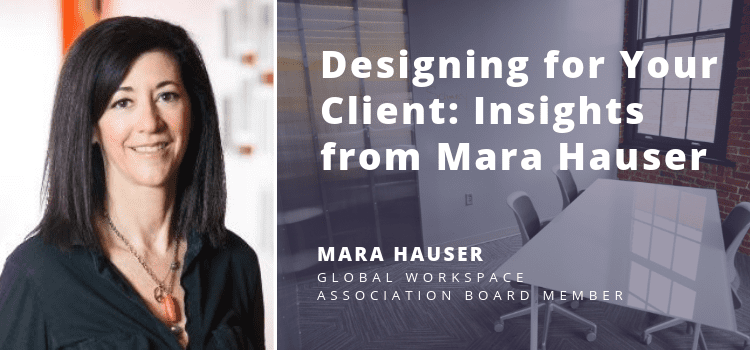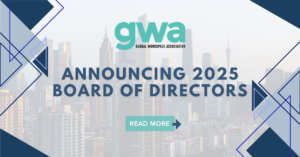Mara Hauser, Founder and CEO of 25N Coworking, sums up her work in the industry simply: “I think about how people work best.”
Hauser currently serves on the Global Workspace Association board, where her background in interior design and workplace strategy, specifically for corporate office spaces, gives her a unique perspective on what makes a coworking space successful.
Know Your Audience
Hauser explained that part of her work has involved talking with a variety of building owners, landlords, and flex office operators—both in and out of the coworking industry—about their goals for the space. Ultimately, the type of client a coworking space is designed to reach becomes critical to client attraction and retention.
However, Hauser has found that when she asks space owners and operators who their target audience is, she often gets answers such as “people in the tech industry,” or “people who work from home.”
“But that’s not my question,” Hauser said. She likens the process to buying a car: some people really like certain makes and models of cars, but these preferences are largely determined by how and why the person will drive the car
For example, attorneys and financial planners, Hauser notes, have vastly different needs than an accounting firm. Attorneys and financial planners require private spaces to communicate with their clients—accounting firms need comfortable furniture and lighting for long hours at their desks. These types of needs determine everything from workspace flexibility to décor, and profession isn’t the only factor.
Hauser said it’s also important to cater to personal preferences. How do they like to work? Do they like to be around people? Will they need 24/7 access? Are they in a suburban or urban environment? Do they prefer a dedicated conference room? Do they like to plan ahead, or do they need accommodations for impromptu meetings or important phone calls? What kinds of amenities—such as whether or not to have alcohol available—will be best suited to this type of person?
When sitting down with an owner or operator whose space she is helping design, Hauser said she always starts with an “ideation session,” which includes an extensive questionnaire to help identify the specific clientele the space is targeting. Having that clear idea can be the difference between a successful space and an unsuccessful one.
Elements of a Coworking Space
“Each coworking space has its own brand and culture,” Hauser said. Ineffective space design often comes down to two main problems: either the space tried to copy another design scheme instead of developing its own, or it designed a space without considering all angles of the user experience. Great design isn’t just about aesthetics, Hauser explains, which is why many spaces end up with a suboptimal design when they choose to mimic the layout or features of another space they’ve seen.
Identical designs across multiple company locations can be equally problematic, both because the spaces lose their uniqueness and because they lose functionality for their local target market. To truly design a space well, Hauser said color and style are only part of the discussion process. It’s also important to understand the workflow of the intended user, which affects everything from the arrangement of desks to the placing of electrical outlets and light fixtures.
This is especially important when designing a coworking space, Hauser explained, not only because coworking caters to so many clients, but also because “clients come to the space with unique expectations as far as design for productivity.” Businesses coming into coworking are often doing so because a traditional lease is seen as a liability, but they still have specific needs for their team. In addition, many come to coworking looking for networking, partnerships, and mentorship opportunities—and great design supports those needs.
“As businesses, what do we need flexibility for?” she asked. “The ability to create spaces—and communities—to foster flexibility and collaboration is what I love to do.” And strategic design gives her the tools she needs to make these successful workspaces a reality.
“For me, it’s just amazing that we have the resources and insights to do so,” she said.
Bring in the Experts
Because design becomes the backbone of a successful space, Hauser says it’s important to bring the right expertise to bear on the design process.
She recommended that any operator enlist the help of an outside expert in workspace design for, essentially, the same reason a client comes to a coworking space: “You can’t grow your business without focusing on the tasks that are [direct] revenue producers.”
“At the same time, you can’t let the design suffer. When you engage a designer, you don’t have to worry about anything except your business,” she said.
In addition to 25N Coworking, Hauser also runs a design firm, Workplace Studio, which helps coworking owners and operators design their space effectively.
“We know what it takes to design, create, build out, and run a coworking space,” she said. “It takes a lot of time to create a space, and we can expedite that by matching our clients with the right resources and the right people.”
A good design team will understand not just the aesthetic details normally associated with design, but also layout, procurement of materials, the best vendors, appropriate price points, how to tie a design package together effectively, how to manage an acquisition schedule for furniture and equipment, and how to fit the lengthy design process into other business processes.
Having a designer work with your space not only ensures expert opinion, but it also saves time and money in terms of demands on staff.
“In the end, the right designer should save a whole lot of money, time, and energy,” Hauser said.
Will the Client Notice Bad Design?
“A well-designed space flows well and feels good” Hauser said. Even though a client may not consciously notice design, they will notice when they don’t want to work in a certain environment.
Design components that are out of scale or don’t flow as you move through the space lead to lost productivity and low enjoyment—and these are the pitfalls a good designer knows how to avoid.
“It’s second nature to a good designer,” Hauser said. “We study how people work and work best.”
Design and the Future of Coworking
Hauser thinks that the next phase of coworking will see a need for excellence in both design and the ability to scale. As businesses move to become more flexible in their offerings and the types of clients they serve, they have to be able to pivot quickly and efficiently without losing the integrity of their space design.
“It’s a forward-thinking mentality that won’t sacrifice quality in the long run,” she said.
Understanding the industry’s trends, innovations, and best practices and getting these expert insights into coworking’s hot topics are some of the primary benefits of the GWA, according to Hauser.
“I just see that future success stories are those leaders who are able to take a company to the next level,” Hauser said, “Which means that they keep flexible—keep nimble—and are watching and learning all the time.”




